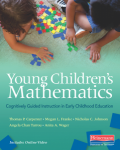
Adapted from Young Children's Mathematics: Cognitively Guided Instruction in Early Childhood Education
by Thomas P. Carpenter, Megan L. Franke, Nicholas C. Johnson, Angela Chan Turrou, and Anita A. Wager
Supporting the Development of One-to-One Correspondence
Developing one-to-one correspondence occurs as children work to coordinate the counting of each object with one and only one number word. You can support the development of one-to-one correspondence by counting together with children, emphasizing matching the action of pointing, touching, or moving each object with the saying of a single number word. Or you might pose a question to the student such as, “How will you keep track of which ones you’ve counted and which ones you haven’t counted yet?” Some children benefit from putting the objects into a container as they count (such as during clean up), as it slows down their count and focuses them on one object at a time. Other children find that spreading out their collection or working with a partner is helpful. However, supporting children to use strategies to keep track of the objects counted will not immediately move children to use the one-to-one principle. Developing understanding of and the ability to use the one-to-one principle takes time and a range of experiences.
| Learning One-to-One Correspondence NOTE: These do not develop in any particular order. |
|
| Child’s Understanding |
Example (counting a collection of 6 colored discs) |
| Move discs one at a time, no counting words |
Put them one at a time on a plate |
| Touches some discs and not the others, one number word for each |
1,2,3,4,5 |
| Touches each disc and at times says more than one number word |
1,2,3,4,5,6,7 |
| Moves each disc one at a time, saying one word for the first few |
1,2,3 |
| Touches the discs in the pile, saying one number word for each disc at the beginning and the end but not in the middle |
1,2,3,4,5,6,7,8
|
| One number word for each object with one kind of object, but not discs. |
|
| One number word for each object counted |
1,2,3,4,5,6 |
Watch the following clip of a student counting. What do you notice?
 Thomas Carpenter is Emeritus Professor of Curriculum and Instruction at the University of Wisconsin–Madison.
Thomas Carpenter is Emeritus Professor of Curriculum and Instruction at the University of Wisconsin–Madison.
Megan Franke is Professor of Education at the University of California, Los Angeles.
Nicholas Johnson is a Doctoral Candidate in Urban Schooling at the University of California, Los Angeles.
Angela Chan Turrou is a researcher and teacher educator at the University of California, Los Angeles.
Anita Wager is Associate Professor in Curriculum and Instruction at the University of Wisconsin–Madison.
How would you support this student's development of one-to-one correspondence?



